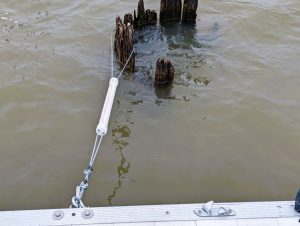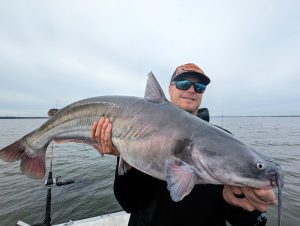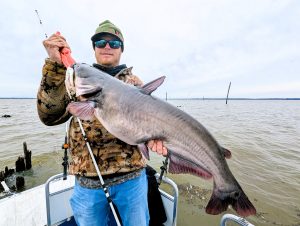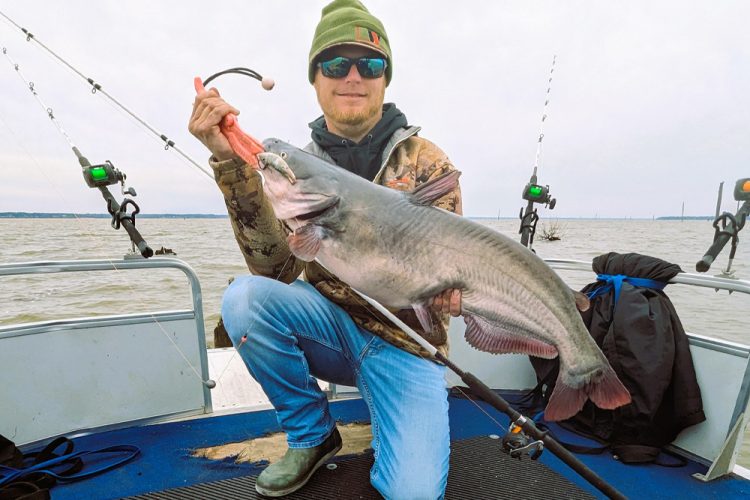When guide Kyle Austin sets up on the right spot, fast action is the norm for the Stump Jumpin’ tactic.
Stump Jumpin’ for Winter Cats
Story and photos by Terry Madewell
Stump Jumpin’ for winter catfish is a fast-paced technique that requires plenty of effort from guide Kyle Austin, but the rewards are worth it.
Catfishermen know that winter fishing offers opportunities to catch quality catfish, and blue catfish are primary targets as water temperatures cool toward annual lows. But catching fat flathead and chunky channel catfish are also possible.

Anglers understand that catfish orient to ledges, humps, and holes in cold weather, but they also relate to woody cover, and the low water temperatures of December can be a prime time for that cover-connection.
Kyle Austin is a 27-year-old professional catfishing guide on the Santee Cooper lakes and the Ridgeville, SC. When fishing goes cold on traditional tactics, Austin resorts to his wintertime favorite he calls Stump Jumpin’.
“I grew up doing this on the Santee Cooper lakes,” Austin said. “I’d maneuver through the standing dead tree forest on the lower end of Lake Marion, pick a cluster of trees, and randomly start fishing. By trial and error, I found spots that consistently produced. Now I apply advanced electronics and I link fish and forage patterns to determine where catfish congregate. It’s a reliable pattern when other techniques get slow.”
Austin is a highly successful professional bass tournament fisherman and guide, and his bass-catching electronic wizardry has enhanced his wintertime catfishing success.
“I’ve learned that when the water temperature gets low, and for Santee Cooper lakes that’s in the low 50s and down into the mid-40s, the drift fishing pattern isn’t as productive,” he said. “When this occurs, Stump Jumpin’ is usually productive and as a catfish guide, I need a reliable cold-weather pattern.”
Lake Marion, the upper of the two Santee Cooper lakes, is his primary target because the standing timber left in the lake when impounded flooded thousands of acres of deepwater flats, inundated by 20-to-40 feet of water.
Austin (843-209-3726; Kyle Austin Fishing on Facebook) said the typical pattern in late fall is drift fishing but when the water temperatures drop toward the low of the year, that fishing pattern slows. That’s his cue to head to the dead tree flats.
“Finding the right spot for the day we’re fishing is the key,” he said. “The right blend of forage, weather, water temperature, and current flow is crucial.”
Austin looks for telltale signs of forage, including the presence of gulls or cormorants, because they’re typically close to forage. Employing electronics, he also searches for multiple pods of forage with big fish marked nearby.

“When I find shad pods clustered in an area where I find a tight cluster of stumps or visible trees, that’s my target,” he said. “I’ll select a central stump or tree as a focal point.”
Austin has learned from his electronics that locating ditches and depressions in these stump flats enhances productivity. When forage clusters in an area near these natural catfish travel routes, it enhances big fish potential.
Austin has developed a metal cable rig that he attaches to the bow of his roomy tri-toon rig. He slips the cable over a stump and tightens it securely if standing trees are unavailable. The rig enables a quick dis-connect, an essential part of this tactic.
“I’m generally patient when catfishing, but not with this tactic,” Austin said. “Giving catfish about 10 minutes to bite is my standard, and then I pull rigs and move. Waiting can produce bites, but if an area is going to produce multiple fish the bites occur quickly.”
When he finds an area with active fish, the bite is fast-paced, and the odds of multiple catfish hooked simultaneously are high.
Austin fishes vertically beside the boat and casts baits to other woody targets around the boat via flatlines.
“I’m fishing the area, not one tree or stump, so I target cover further away,” he said. “I saturate the water with bait and I’ll cast baits into the middle of a tight cluster of trees or stumps.
“Isolated targets, where several stumps or trees are nearby, often hold multiple catfish, and when that produces, I focus multiple rigs in that area,” he said.
Austin prefers blueback herring, gizzard shad, and white perch as his December bait preferences.

“White perch are a consistent year-round bait at Santee Cooper, especially for trophy catfish,’ he said. “But herring and gizzard shad are effective and I use a blend of all three until I determine a bite preference on a given day.
When the bite is active, it’s fast-paced, but a sudden slowdown puts Austin back on the 10-minute clock.
“Once I find an area where catfish are clustered, I may move only a hundred yards to find more biting catfish,” he said. “When I catch multiple fish in an area, I’m searching close to find another localized hotspot. They’re clustered in that area for a reason.”
While most catfish caught are blues, flathead and channel catfish are in play. Austin said a heavy rain event that creates a mudline in the stump flats attracts flatheads. When that condition occurs, the flathead action becomes more consistent, and he’ll have trips with multiple flatheads boated, along with the blue and channel catfish.
Austin employs a different for fishing this heavy cover and he uses a 7 ½ foot medium-heavy rod, compared to medium-light for drifting. The extra backbone is often needed to pull heavy catfish out of the gnarly cover. He spools the reels with a 50-pound test monofilament, a 30-pound test leader, and a 5/0-to-7/0 Gamakatsu circle hook.
“Despite this action being best when water temperatures fall to the lowest point of the year, big fish are in play,” he said. “Many catfish range in the 10-to-20-pound class, but we’ve boated blues over 60-pound using this tactic. Catching trophy catfish is realistic, and boating many hefty fish is typical.”
Austin said Stump Jumpin’ requires some patience to locate the productive areas, but little patience is best before moving when fast action turns slow. The consistent success rate is such it’s his ‘go-to’ winter tactic.
(Terry Madewell of Ridgeway, S.C. has been an outdoor communicator for nearly 50 years. He holds a degree in Wildlife and Fisheries Management and has a long career as a professional wildlife biologist/natural resources manager. He’s passionate about sharing outdoor adventures with others.)



